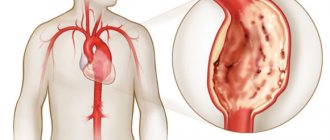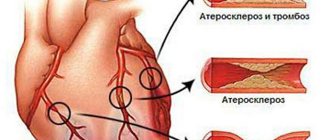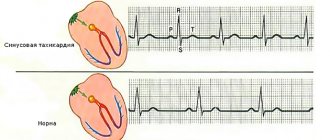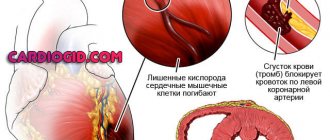Frederick's syndrome is a deadly organic pathology. Its essence lies in the disruption of the normal conduction of electrical impulses through cardiac structures.
In the presence of disease, the signal is not transported from the atria to the ventricles, circulating in the upper chambers in isolation, which leads to a significant drop in myocardial contractility.
The result of the pathological process is fatal arrhythmias, which sooner or later are very likely to lead to cardiac arrest, cardiogenic shock or heart attack.
Third-party emergencies are also possible, which are caused by a violation of the general blood flow.
Recovery is expected in theory, but in reality there are no options other than surgical treatment, and surgical intervention does not guarantee complete management of the condition.
Development mechanism
The essence of the process becomes clear if we take into account the anatomical and physiological features of the work of cardiac structures.
Normally, the functional activity of the heart is constant and is determined by the generation of an electrical impulse by a special accumulation of myocyte cells. It is called the sinus node or natural pacemaker.
Next, the excitation is transmitted through special bundles from the atria to the ventricles. There is an alternating, complete contraction of the myocardium along its entire length.
This phenomenon is accompanied by an intense release of blood into both circles: small and large, providing both adequate gas exchange and nutrition of all tissues and systems.
Frederick's syndrome is characterized by disruption of the normal conduction of cardiac structures. The changes correspond to a complete blockade.
The electrical impulse does not reach the ventricles, but moves in a circle in the atria, which leads to the emergence of a dual mechanism:
- The upper chambers begin to contract chaotically or correctly, but excessively quickly.
- The lower ones generate their own signal, becoming excited.
Hence the fluttering, fibrillation. More often the process affects all cardiac formations, and therefore is the most severe.
The result is a drop in myocardial contractility, disruption of the normal rhythm, decreased blood output, changes in the nature of hemodynamics, hypoxia, insufficiency of work of both the muscular organ itself and remote systems.
This generalized nature of the deviations explains why the mortality rate of the condition is at the average level of 96-98%.
Description of the syndrome
Frederick's syndrome is a combination of symptoms that are characteristic of complete transverse block and atrial fibrillation.
With this deviation, electrical signals completely stop flowing into the ventricles from the atria, which lose the ability to contract regularly and in an orderly manner.
The absence of excitatory impulses causes the formation of foci in the walls or lower part of the atrioventricular node of the ventricles, which independently begin to produce electrical signals. This becomes a kind of compensation, but does not save the situation, since the pulse frequency is insufficient (maximum forty to sixty signals).
As a result, the ventricles of the heart contract more slowly than in a healthy person, which means the blood flow slows down, which causes oxygen starvation and is the main danger of the disease called “Frederick's syndrome.”
Frederick's syndrome is characterized by clinical signs that occur with complete transverse block. To explain it more clearly, with the syndrome the atrium contracts irregularly, chaotically, fibrillation constantly occurs, which can be replaced by atrial flutter. What are the reasons for the development of this dangerous syndrome? Is it possible to treat Frederick's syndrome?
Causes
The described phenomenon is never primary; it is always secondary in origin to one or another disease. The pathological factors for the development of Frederick's syndrome are as follows.
Disorders of the functional activity of the thyroid gland
It can be called hypothyroidism, that is, insufficient production of specific hormones. But that's an understatement.
Deficiency in itself does not entail a violation of conductive capacity; such syndromes are formed as a result of subsequent pathologies. Myxedema occurs against the background of hypothyroidism.
This is a complex deviation on the part of the whole organism, it is characterized by total dysfunction of the body. The elasticity of the dermal integument decreases, the activity of the heart, liver, and kidneys is disrupted.
The proliferation of so-called “fast” cells (skin, hair, nails) decreases, and general swelling occurs. The quality of life drops significantly. The picture is crowned by the presence of dangerous arrhythmias.
If treatment is not started promptly, Frederick's syndrome will put an end to the history.
Coronary heart disease or ischemic heart disease
Develops as a result of a heart attack, coronary insufficiency, trauma, tumors and atherosclerosis.
The essence of the pathological process lies in the malnutrition of the muscle layer. Gradually, little by little, it undergoes degeneration and is replaced by scar tissue.
Terrible complications, such as dangerous arrhythmias, begin in a relatively late period, when recovery becomes impossible by any means.
Treatment is supportive and does not guarantee the absence of lethal consequences. The ideal option is therapy at an early stage, when the chances of stabilizing the condition are still high.
Lung cancer in any phase
It manifests itself most clearly from the position of cardiac structures at stages 3-4, when the tumor reaches sufficient size on the one hand (compression of the chest organs occurs), on the other, active decay of neoplasia and poisoning of the body occurs, the load on the heart increases significantly.
The prognosis of Frederick's syndrome of this etiology depends on the prospects of the cancer itself.
If the neoplasm and metastases to regional lymph nodes are eliminated, there is a chance for a long and relatively healthy life without significant limitations. But, as a rule, at stage 3, especially stage 4, the chances of such an outcome are small, if not ghostly.
Myocardial infarction
IHD crowns itself, becoming its natural outcome. Avalanche-like death of cardiac structures develops when a certain critical mass is reached due to circulatory disorders at the local level.
Recovery and its prospects depend on the extent of the lesion. The larger the changes, the more tissue is scarred and, accordingly, the weaker the contractility of the myocardium.
Frederick's syndrome develops as a result of disturbances in electrical activity, as well as destruction of conductive structures.
Coronary insufficiency
It exists in the form of unstable angina (so named for its ability to progress, leading to a fatal outcome in a relatively early period) or as acute cell death (necrosis).
The first inevitably turns into the second, it’s a matter of time. The duration of deviations is indefinitely long.
It is impossible to predict anything, but against the background of gradual destruction of the conductive tracts and gross fusion of dead tissue, Frederick's syndrome develops in 5-10%.
Inflammatory lesions of cardiac structures
Myocarditis, endocarditis, pericarditis. They are accompanied by severe symptoms, which makes diagnosis relatively simple and quick.
In this case, recovery is carried out strictly in a hospital setting, in order to avoid fatal complications.
Diseases are of infectious or autoimmune origin.
With an aggressive course of the process or a late start of therapy (usually both), destruction of cardiac structures occurs, similar to infarction or more severe. The result is sclerotic changes, conduction disturbances.
Cardiomyopathy
Decreased functional activity of the muscle layer of the organ. It is rarely primary; genetic abnormalities or anomalies of the perinatal period are possible.
More often, this is the development of disorders during life that are difficult to treat even in the early stages. It is possible to maintain and stabilize the condition; there are no radical ways.
Rheumatism
Inflammation and subsequent destruction of the heart of an autoimmune nature. The rate of progression depends on the initial data: the patient’s health status, the strength of the immune response, and others.
Congenital and acquired heart defects
They arise as a result of genetic pathologies, spontaneous phenotypic disorders, incorrect, dangerous lifestyle, past infectious and other diseases.
Surgical treatment is aimed at restoring the anatomical integrity and activity of the muscular organ.
Collagenoses
Diseases associated with deviations in the regenerative ability of connective tissue. There are several such collagenoses; which one develops must be assessed based on diagnostic results.
Causes are eliminated gradually during the diagnostic process. Data for pathology are not always present. Then an idiopathic form of Frederick's syndrome with an unknown origin is stated.
Prevention
Doctors do not name any specific measures to prevent the development of Frederick's syndrome. This condition occurs due to various heart pathologies. To avoid problems with the functioning of this organ, people should adhere to the basic principles of a healthy lifestyle.
The following is recommended:
- Exercise. It is worth remembering that physical activity should be moderate. Under no circumstances should you overload your heart.
- Eat properly. The condition of blood vessels depends on the foods consumed, the failure of which negatively affects the activity of the heart.
- Stop smoking and drinking alcohol. Bad habits adversely affect the body's condition, causing oxygen starvation and intoxication.
- Visit a cardiologist annually for a preventative heart examination. This is the most important measure, only thanks to which it is possible to detect heart disease in a timely manner and safely get rid of it.
Thus, Frederick's syndrome is a serious pathological condition that indicates a disturbance in the functioning of the heart and leads to serious consequences. A person’s future life depends on the timely detection and treatment of the disease.
Risk factors
There are so-called risk factors that do not directly cause the onset of pathological changes, but actively push the body to the line:
- Genetic predisposition. Heredity plays an important role. As was said, some of the deviations are transmitted as a result of disorders of intrauterine development, others - as a result of a fundamental change during the process of embryogenesis.
- Frequent inflammatory and infectious diseases of one kind or another.
- Long-term or improper use of heart medications, antihypertensive drugs, psychotropics, antibiotics, progestin contraceptives.
- Metabolic disorders of generalized type.
Surgery
People with Friedreich's syndrome may require surgery to help maintain functional independence for as long as possible.
If physical and pharmacological treatments are ineffective, surgical solutions are considered to correct the deformities caused by abnormal muscle tone.
Titanium screws, rods inserted into the spine, help prevent or slow the progression of scoliosis. For those suffering from equinus deformity, surgical lengthening of the Achilles tendon improves mobility.
For severe heart failure that does not respond to maximal medical treatment, implantation of an automatic cardioverter-defibrillator or heart transplant is considered.
Watch video advice from a neurologist
Clinical symptoms
Manifestations depend on the duration of the pathological process, the presence of concomitant diseases, age, physical characteristics of the patient and other factors.
The basis of the picture is the following features:
- Swelling of the lower extremities. Based on the severity of pathological changes, we can talk about one intensity or another.
In the early stages, provided that there are no associated pathologies, everything is limited to a slight thickening of the tissue in the ankle area.
There are always two reasons: an increase in circulating blood volumes with the general ineffectiveness of the hemodynamic model of a person suffering from Frederick syndrome, as well as disruption of the excretory system, as a result of the evacuation of fluid from the body.
- Dizziness. The intensity varies. Total impossibility of orientation in space also occurs in the acute period. This usually indicates the onset of an emergency. For example, a stroke or advanced stages of encephalopathy.
- Cephalgia. The pain is localized in the occipital region, parietal lobe. They have a stable, aching or squeezing character. They develop regularly, in paroxysms. Each episode lasts from a couple of minutes to hours and even days.
- Bradycardia. The hallmark of Frederick's syndrome. As a result of a decrease in myocardial contractility due to lack of stimulation, a slowdown in the pulse rate is observed. Sometimes to critical levels: 30-40 beats per minute. Against the background of current bradycardia, disturbances of a different kind are observed. Fibrillation or fluttering, as already mentioned.
In combination, the intense work of the atria and the chaotic activity of the ventricles creates a bright picture on the ECG, but nonspecific. Analytical work is required to make a diagnosis.
- Dyspnea. In the early stages of Frederick's syndrome, in a state of intense physical activity, and then in complete rest. The latter option leads to disability, significantly reduces the patient’s quality of life, and makes it impossible not only to work, but also to care for oneself at home.
- Weakness. Intense, to the point of inability to work normally or perform daily duties.
- Chest pain. Feeling of heaviness, pressure. Episodes of arrhythmias last for several hours, less often than a day. Recovery is carried out using specialized drugs, unless there are contraindications.
Also possible: nausea, vomiting, disturbances in the normal functioning of the liver, gall bladder, secondary encephalopathy with weakening of mnestic and cognitive functions, behavioral disorders (increasing phenomena of vascular dementia), constipation, diarrhea, flatulence.
All this is the result of insufficient supply of oxygen and nutrients to the organs.
Methods to combat the disease
Arrhythmia is the result of irreversible changes in the heart muscle, so treatment for Frederick's syndrome is impossible. Due to its physiological origin, the disease is not amenable to drug therapy. Thus, anticholinergic drugs cannot be used due to the risk of mental disorders.
The patient's condition can only be improved, and life can be extended by implanting an electrical pacemaker. It is a compact device housed in titanium. It is placed over the pectoral muscle on the left or right under the collarbone.
The operation involves the installation of a special electrode that is capable of producing pulses of the required frequency. Thus, the conductor sets the rhythm depending on the age and individual characteristics of the person. The procedure is performed under general anesthesia.
Such an operation is quite complex and is performed in specialized clinics that are designed to treat cardiac abnormalities. Surgery is performed during the daytime to attract more medical personnel.
If the heart rate is less than forty times per minute or if the woman has Morgagni-Adams-Stokes syndrome, pregnancy is contraindicated. The question of the possibility of childbirth with an implanted pacemaker is decided individually in each case. Typically, pregnancy can be maintained if IVR with adjustable frequency stimulation is introduced. Otherwise, the heart will not be able to adapt to hemodynamic conditions that change during pregnancy.
The prognosis and duration of sick leave depend on the severity of the disease and the patient’s health status after surgery, which today is the only way to return to a full life.
Diagnostics
Examination of prospective patients is carried out by cardiologists. Specialized surgeons are involved as necessary.
The activities are:
- Oral questioning of a person regarding his complaints, collection of anamnestic data to objectify symptoms, building an understandable further scheme.
- Measurement of blood pressure (usually slightly deviates from the norm in one direction or another), heart rate (severe bradycardia with an irregular rhythm).
- Auscultation (dull, chaotic tones).
- Electrocardiography. The main technique identifies a group of nonspecific traits that are subject to a thorough comprehensive assessment.
- Echocardiography. Allows you to determine the root cause of the pathological condition, and also identify organic disorders that arose after the onset of Frederick's syndrome. There can be many of these. Defects are acquired relatively quickly, within 1-2 years.
- Daily monitoring is prescribed as necessary. It makes it possible to dynamically assess the functional activity of the heart and identify the slightest disturbances in the pulse indicator.
Other studies are used less frequently. Usually one cardiography is enough. Additional techniques are aimed at verifying and assessing the extent of the problem and acquired complications.
Frederick's syndrome on ECG
- The occurrence of extrasystoles (they fit unevenly into the graph).
- Low heart rate (from 30 to 60, not higher).
- The rhythm may be correct, but more often it turns out to be the other way around (RR).
- Complete disappearance of P peaks, their replacement by F-waves of a sawtooth nature.
- The QRS complex may widen.
The signs of Frederick's syndrome on the cardiogram, as was said, correspond to a complex arrhythmia, but it is only possible to say that this is it with serious analytical work.
Attention:
To make a diagnosis, considerable training in the field of cardiology is required, otherwise errors are likely.
Manifestations of the syndrome
In addition to the classic ECG picture, Frederick's syndrome has very pronounced clinical signs. The combination of two serious arrhythmias leads to a deterioration in the pumping function of the heart. Ineffective functioning of the atria, coupled with rare contractions of the ventricles, causes poor blood flow and oxygen starvation of all organs, including the brain.
Outwardly, this is manifested by severe weakness, dizziness, goosebumps before the eyes and episodes of loss of consciousness. Treatment is necessary because Frederick's syndrome is a potentially life-threatening condition.
Pauses in the heart can be replaced by ventricular tachycardia, and then ventricular fibrillation, which requires electrical defibrillation and emergency care. Prolonged loss of consciousness and oxygen starvation of the brain lead to the death of nerve cells.
The diagnosis is made based on ECG data and clinical manifestations. A cardiologist may order an ultrasound examination of the heart. The most clear picture of the disease is provided by a daily ECG recording (Holter), which determines the work of the heart during physical activity and at rest, and also reflects the frequency of blockade episodes.
Treatment
Therapy is strictly surgical. On the one hand, the origin factors themselves cannot be corrected (scars, myocardial hypertrophy, etc.), on the other hand, the disorder of the conduction system itself is anatomically irreversible. Therefore, there are no alternatives to radical intervention.
At the same time, we can only talk about the ineffectiveness of drug correction.
Indeed, drugs are not capable of changing the situation. But to carry out an operation without careful preparation is not only unprofessional, but also downright stupid, since the risks are too high: the patient may not survive the implantation of a pacemaker.
Urgently, without preparation, a radical technique is indicated only in the case of an acute emergency condition.
During the planned period, antiarrhythmic drugs, antihypertensive medications, cardioprotectors are prescribed, and, as needed, potassium and magnesium supplements.
Specific names, as well as combinations, are selected by specialists; independent use is unacceptable.
Attention:
Cardiac glycosides are not used.
The essence of the operation is the implantation of a pacemaker. It saves lives, but not always.
Creating an additional pathway makes it possible to eliminate arrhythmia or significantly smooth out its symptoms. The pathology is too dangerous.
Effective or conditionally effective treatment is possible only in the early stages. In this case, a good result is the extension of the patient’s life by at least several years.
Possible complications
Possible consequences of the pathological process:
- Cardiogenic shock. A total disorder of cardiac function develops against the background of conduction disturbances, especially often. The lethality of the process is almost one hundred percent, regardless of the form.
- Heart attack. Necrosis of cardiomyocytes and scarring of affected areas.
- Heart failure. It is not accompanied by preliminary symptoms and occurs suddenly. Almost always lead to death due to the unpreparedness of the patient and his loved ones for such a scenario.
- Vascular dementia. Accompanied by signs inherent in Alzheimer's disease. It is potentially reversible at the first stage.
- Stroke.
- Multiple organ failure or dysfunction of individual systems.
Forecast
Prognostic assessments depend on the moment of initiation of therapy, health status, age, body weight, concomitant pathologies and other factors.
By installing a pacemaker, it is possible to improve the likely outcome quite significantly.
If mortality without therapy is 96% or higher, after implantation the figure drops to 25-30% or less; if in addition there are no risk factors, and there are many positive prognostic factors, the likelihood of a long and high-quality life is maximum.
A negative factor that neutralizes all the benefits of radical treatment is the presence of fainting and syncope in the clinical picture. This is a sign of cerebral ischemia. Such patients most often die within 2-4 years.











